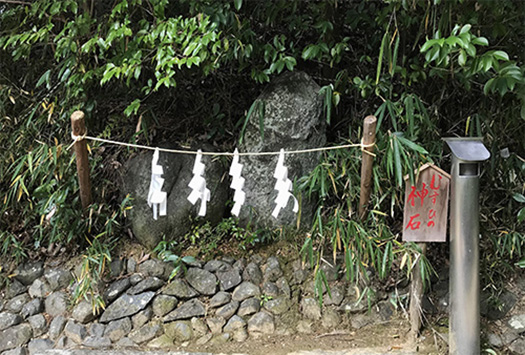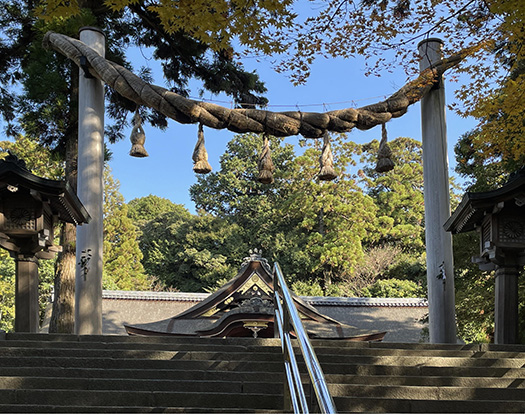
さて本日は古代史の巨大なテーマである自然崇拝から宗教への流れについてであります。いちばん上の写真は奈良県・明日香の「飛鳥坐(あすかにいます)神社」参道の小さな岩にまるで鳥居のような結界マークが施されていて、いかにも始原的な姿を見せて興味深かったもの。この神社にはふつうの鳥居もあるのですが、道脇にひっそりと佇む様子は、意表を突かれる素朴さでこころ奪われる。たぶん始原期の鳥居って、こういう柱に対して結界をあらわす注連縄を回すようなシンプルなものだったのだろう。
日本の歴史では大和平野に成立した神武天皇の皇統が統一政権を樹立する。ヤマトタケルの逸話とか、出雲との「国譲り」などは統一国家成立の「きしみ」のようにも思える。政治的にはそのようなプロセスを辿っていったのは間違いがない。しかし一方で祭政の政ではないマツリの方については「古墳」という形式が箸墓古墳以来の「前方後円墳」が全国を席巻したあと、それが急速に終焉していって、仏教寺院にそれが取って代わられることになる。
きのう飛鳥大仏のことを書いたけれどそれが本尊とされた飛鳥寺以降、四天王寺・法隆寺という聖徳太子が建立に関わる本格的仏教寺院が日本人の精神史の主流を占めることになる。蘇我氏と物部氏の闘争はこういう背景を持って戦われ、蘇我氏の勝利によって一気に仏教寺院全盛の時代を迎えることになる。古墳はあれだけたくさん作られたのにまるで夢幻のように一気に放棄されていくのに、強い社会的整合性があったのだろうか。仏教の導入によって完全にその位置が置換されてしまった。そういう中にあって、神社はまったく独特に信仰心を集めていたといえる。

2番目の鳥居は三輪山をご神体とする大神(おおみわ)神社の拝殿に至る最後の鳥居なんですが、柱に注連縄が渡されているのみのシンプルなもの。三輪山自体に注連縄を回しているというようにも受け取れる。スケールはまったく違うけれど上の写真の飛鳥坐神社参道脇の鳥居とも通底する。

そして3番目は西宮の廣田神社の標柱とされる鳥居。ふつうの鳥居もこの鳥居を挟むようにあるのですが、なぜかこのシンプルな鳥居が印象的に建てられている。
そういえば夫婦岩などでも自然岩石に注連縄を回して結界としているので、神社信仰は本然としては列島に素朴に根付いた自然崇拝の昇華形態だったのではないか。
古墳とか仏教寺院に対して神社は日本的精神では次元を異にする存在なのでしょうね。こういうありようというのは東アジアでは日本以外にはあまりない形式。どうも神社は無色透明のような雰囲気でどんな宗教ともケンカしない文化を保持しているように思う。そういうのが日本人的な心の持ちようを表しているのか。皇室という現実の存在があることで神社はこういった無色性を得たものとも思える。宗教と言うよりそれ以前の精神性がある。こういう奇跡のような平明な精神性は大切に受け継いでいきたいと思う。
English version⬇
Torii and the Boundary: A Spiritual History of the Japanese People (The 37,000 Year History of the Archipelago, Vol. 59)
Kofun tumuli disappeared like a dream by Buddhist temples. They were replaced by Buddhist temples. Shrines based on nature worship did not fight with each other and remained unchanged. …
Today, I would like to talk about a huge theme in ancient history, the flow from nature worship to religion. The top photo shows a small rock on the approach to Asuka Shrine in Asuka, Nara Prefecture, with a boundary mark like a torii (a Shinto shrine gate), which is interesting because of its primitive appearance. This shrine also has an ordinary torii gate, but the way it stands quietly by the side of the road is surprisingly simple and captivating. The torii gate in the primitive period was probably a simple affair, with a shimenawa (a rope used to tie a boundary) tied to a pillar like this.
In Japanese history, Emperor Jinmu established a unified government in the Yamato Plain. The anecdotes of Yamatotakeru and the “handover of the land” to Izumo seem to be the “creak” of the establishment of a unified nation. There is no doubt that the political process followed such a path. On the other hand, as for the “mitsuri,” which is not a political process, the “kofun,” or ancient burial mound, has rapidly come to an end after the “front-rear round burial mounds” since the Chopstick Tomb Tumulus swept the nation, and was replaced by the Buddhist temples.
After Asukadera Temple, where the Great Buddha of Asuka was regarded as the principal image, Shitennoji Temple and Horyuji Temple, both of which were constructed by Prince Shotoku, came to dominate the spiritual history of the Japanese people. The struggle between the Soga and Mononobe clans was fought against this background, and with the victory of the Soga, the era of Buddhist temples came to an all-time high. I wonder if there was a strong social consistency in the fact that so many kofun tombs were created but then abandoned at once as if they were a mirage. Their position was completely replaced by the introduction of Buddhism. In such a situation, it can be said that shrines attracted devotion in a totally unique way.
The second torii is the last one leading to the hall of worship of the Omiwa Shrine, whose deity is Mt. Miwa, but it is a simple one with only a shimenawa (sacred rope) passed around the pillar. It could be taken as a sign that the shimenawa rope is being passed around the mountain itself. It could be taken as if a shimenawa rope is being passed around Mt. Miwa itself. Although on a completely different scale, this torii is similar to the one on the approach to Asukazaza Shrine in the photo above.
And the third is a torii gate that is said to be the marker of Hirota Shrine in Nishinomiya. There is also an ordinary torii gate flanking this one, but for some reason, this simple torii gate is built in an impressive manner.
Come to think of it, since a shimenawa (sacred rope) is used as a boundary around natural rock formations, such as the married couple rocks, shrine worship may have been a sublimated form of nature worship that took root in the archipelago in a simple and natural manner.
In contrast to ancient burial mounds and Buddhist temples, Shinto shrines are a different dimension of the Japanese psyche. This type of worship is not found anywhere else in East Asia except in Japan. Shrines seem to maintain a colorless and transparent atmosphere, a culture that does not fight with any religion. I wonder if this is an expression of the Japanese mindset. It seems to me that shrines have acquired this kind of colorlessness because of the actual existence of the imperial family. There is a spirituality before religion. This kind of miraculous, plaintive spirituality is something that I would like to pass on with great care.
Posted on 1月 5th, 2023 by 三木 奎吾
Filed under: 歴史探訪







コメントを投稿
「※誹謗中傷や、悪意のある書き込み、営利目的などのコメントを防ぐために、投稿された全てのコメントは一時的に保留されますのでご了承ください。」
You must be logged in to post a comment.